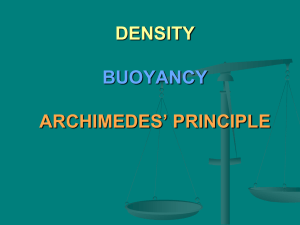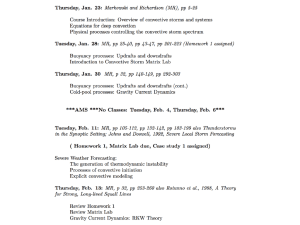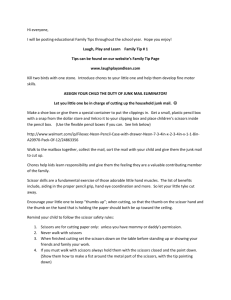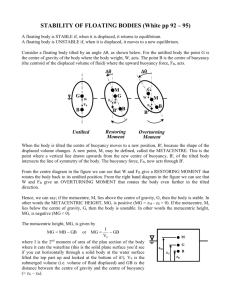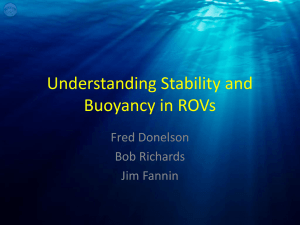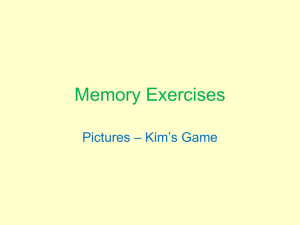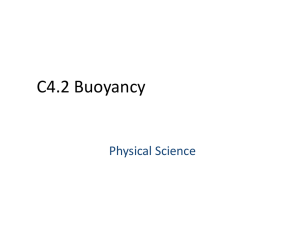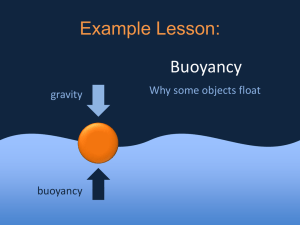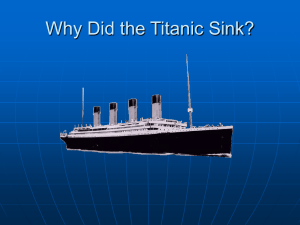High School Lesson Plan
advertisement
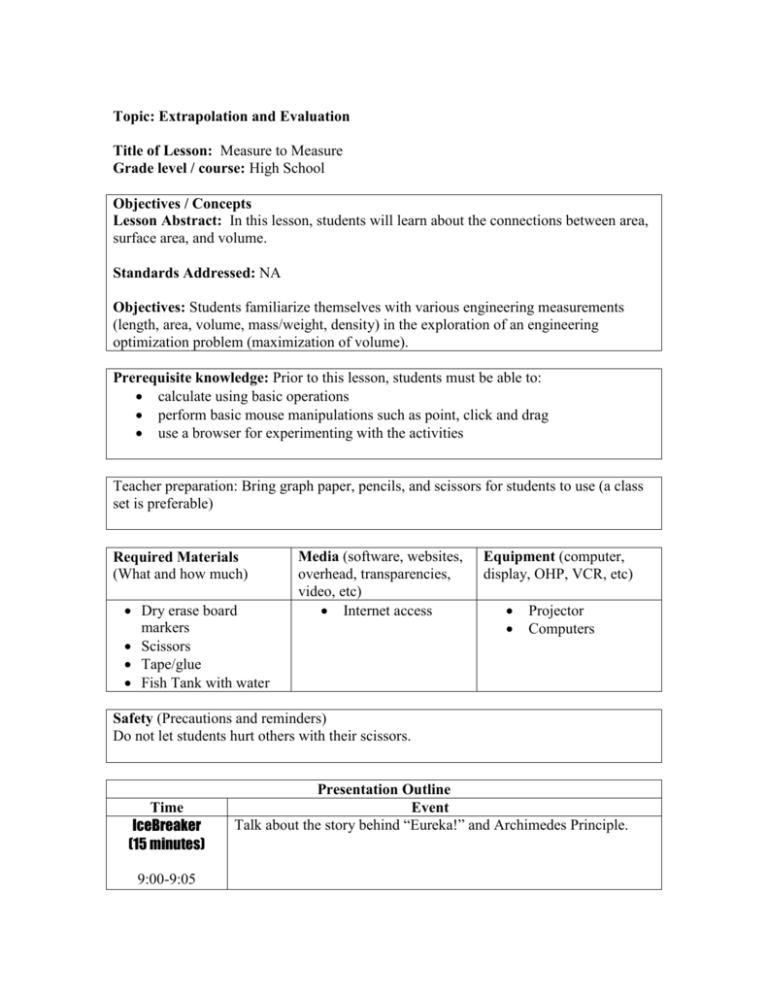
Topic: Extrapolation and Evaluation Title of Lesson: Measure to Measure Grade level / course: High School Objectives / Concepts Lesson Abstract: In this lesson, students will learn about the connections between area, surface area, and volume. Standards Addressed: NA Objectives: Students familiarize themselves with various engineering measurements (length, area, volume, mass/weight, density) in the exploration of an engineering optimization problem (maximization of volume). Prerequisite knowledge: Prior to this lesson, students must be able to: calculate using basic operations perform basic mouse manipulations such as point, click and drag use a browser for experimenting with the activities Teacher preparation: Bring graph paper, pencils, and scissors for students to use (a class set is preferable) Required Materials (What and how much) Dry erase board markers Scissors Tape/glue Fish Tank with water Media (software, websites, overhead, transparencies, video, etc) Internet access Equipment (computer, display, OHP, VCR, etc) Projector Computers Safety (Precautions and reminders) Do not let students hurt others with their scissors. Time IceBreaker (15 minutes) 9:00-9:05 Presentation Outline Event Talk about the story behind “Eureka!” and Archimedes Principle. SA and Vol. 9:05-9:45 We will have them follow online lesson plan: SA activity o Have activity to set up multiple trials with paper models exploring 1, 2, 3, and 4 square height boxes. o Calculate the SA of each and record o Explore with model o Make sure students understand why model does not show what activity does Volume Activity o Have students re-measure each cube size to calculate volume Optimization Activity o Have students calculate using their data which model has both the most surface and the most volume Title of Lesson: What A Sinker Grade level / course: Middle School/High School Objectives / Concepts Lesson Abstract: In this lesson, students will expand their knowledge about unit measurements and volume to learn about density and buoyancy. They will connect the ideas of density with measuring the volume of water displaced to find the buoyancy of different objects made with varying material components. They will then be connected to ships and the applications of buoyancy. Standards Addressed: NA Objectives: to use volumes to connect mass, density, and buoyancy to show another aspect of engineering in the world today, demonstrating real life applications of measurement and optimization concepts. Prerequisite knowledge: Prior to this lesson, students must be able to: calculate using basic operations perform basic mouse manipulations such as point, click and drag use a browser for experimenting with the activities use a ruler to take measurements Teacher preparation: Fill a graduated cylinder and a small tub (preferably glass or clear plastic) with water. Set up classroom to handle the water in case of spills. Required Materials (What and how much) Dry erase board markers Scissors Tape/Water resistant and quick drying glue Marbles Laminated cardstock Plastic/foam cups Graduated cylinder Varying density material set Media (software, websites, overhead, transparencies, video, etc) Internet access Equipment (computer, display, OHP, VCR, etc) Projector Computers Safety (Precautions and reminders) Keep water away from computers, and do not let students hurt others with their scissors. Time Density 9:45-10:35 Presentation Outline Event Discuss the relations between mass, density, and volume. Introduce *Density* Applet that calculates the density or mass based on information inputted by students. Show how Archimedes’ Principle is used to calculate the volume of an object, and then massing can be used to calculate the density. Explain Buoyancy and floatation. Explain that the volume of the water displaced times the density of water (mass of the water displaced) is equal to the mass of the object displacing that water. Begin First challenge: o Groups assigned numbers, will be randomly assigned based on position o Based on number will be given two samples to mass and find the density of. Based on the densities, students will then use a table of values posted on the board to guess what their samples are made of. Students will find volumes using Archimedes’ Principle, dropping masses into breaker of water and measuring the difference in water level. BREAK (15 minutes) Students will use rafts in similar set up to find masses. They will place their cylinders in the raft and measure the change in the water level. They will then calculate the mass of the water displaced when the object was added, which gives the mass of the cylinders. o The groups who guess correctly will be given points First Summary Challenge: Once everyone finishes with their samples, one final challenge to determine the densities. Will use an unusually shaped object to challenge the students. First to get the correct answer as to what it is made of will win. BREAK!!! 10:35-10:50 Challenge and Conclusions 10:50-12:00 LUNCH (15 minutes) Introduce Buoyant Force and Floatation. Discuss balance of forces for static, floating objects. Begin Second Challenge o Same groups as before, groups will be given 20 minutes to design a “boat” o Boat must be made with laminated paper o Completed boats will have cup attached to them and will be placed in the water. o Marbles will be added to the cups, starting with five when boat is put in the water. o Boat with the most marbles without sinking wins. Connections and Applications: Modern Tankers and Submarines o Explain how these properties are used in ships and submarines. o Pose question: if box shape holds weight so well, why do ships and subs not have box shapes? Introduce resistance concepts LUNCH!! 12:15-1:30 Title of Lesson: The Sky’s no Limit Grade level / course: Middle School/High School Objectives / Concepts Lesson Abstract: In this lesson, students will connect the ideas of resistance introduced in the previous lesson to begin to explore the field of aerospace engineering and some of the concepts behind flight. Standards Addressed: NA Objectives: to use the information provided about wing design and online applet tool to create a model *wing/plane* and successfully reinforce hypothesis testing and the practice of extrapolating models. Prerequisite knowledge: Prior to this lesson, students must be able to: calculate using basic operations perform basic mouse manipulations such as point, click and drag use a browser for experimenting with the activities use a ruler to take measurements Teacher preparation: Set up wind tunnel. Required Materials (What and how much) Dry erase markers *Air Gun Sharpies Scissors *Feather-tube demonstration Fan with variable speed controls Cardboard box tunnel to focus fan Wood set up to hold models in airstream Media (software, websites, overhead, transparencies, video, etc) Internet access Equipment (computer, display, OHP, VCR, etc) Projector Computers Safety (Precautions and reminders) Keep water away from computers, and do not let students hurt anyone with their scissors. Presentation Outline Time Event Introduce wind/air resistance. Discuss through connection with Air resistance And Aerodynamic water’s resistance to ships’ movement, and gas as matter. Fan or Air Gun demonstration Applications Discuss effects of Air Resistance and Drag Feather and Marble Drop Demonstration 1:00-2:30 Discuss application to Helicopters and Airplanes Show video clips of helicopter take-off, landing Show the way airplane wings generate lift Introduce Lift Applet o Have students perform small activity to become familiar with workings Introduce First AE Challenge Students, using a set of foam board wings, will try to find a wing that will be able to lift the weight off the ground. May have 2 test runs and one final run in the wind tunnel Must use only the foam board given Will be given a selection of 5 sizes to use May want to use the Lift Applet to test designs prior to trial runs Will have 30 minutes to make final design Wrap up with real world connections: Airbus and large freight aircraft Break!!!! Break 2:30-2:45 Aircraft and Aerospace Engineering Expand on air resistance relative to wings, compare to Reflections How can volume relate solid and liquid objects as a form of measurement? 3:45-4:00 Density is a measure of what? Buoyancy is determined how? What is the main trait that affects buoyancy? Is air resistance something that we can always just “assume to be negligible?” Why/Why not? If not when would it not be appropriate? Assessments Pre assessment: Formative Assessment: Summative Assessment (if applicable): Bibliography Footnoted list of resources used in support of the lesson
